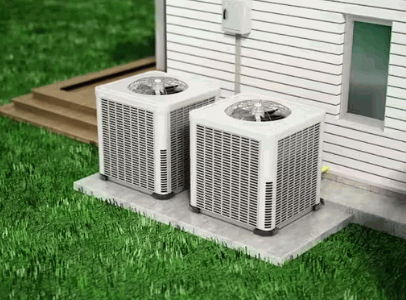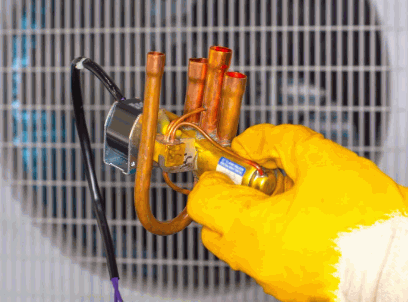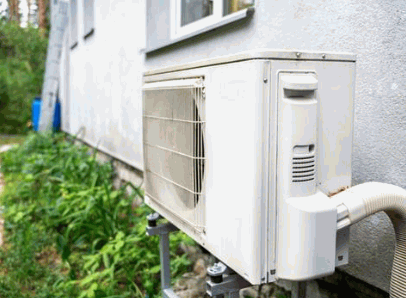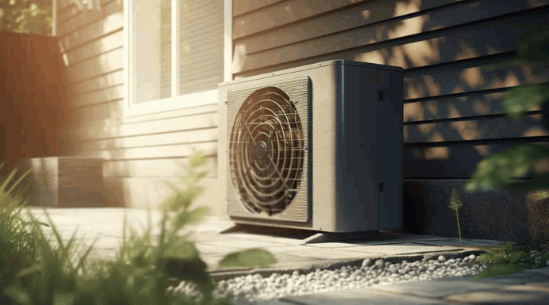As energy efficiency and environmentally friendly solutions gain popularity, air source heat pumps (ASHPs) are emerging as a versatile option for both home heating and cooling, offering the benefits of modern heat pump technology.
This article explores what an air source heat pump is, how it operates, and its ability to cool your home effectively, highlighting its dehumidifying capabilities and energy savings potential.
It discusses the benefits of using an ASHP for cooling, including energy savings, reduced environmental impact, and improved cooling efficiency, while also addressing potential drawbacks.
By the end, you will have a clearer understanding of whether an air-source heat pump is the right choice for your home’s cooling needs, especially in terms of energy efficiency and variable speed performance.

What Is An Air Source Heat Pump?
An Air Source Heat Pump (ASHP) is an energy-efficient heating and cooling solution that leverages heat pump technology to provide both winter heating and summer cooling to homes, making it a versatile HVAC system choice. Unlike a conventional AC unit, an ASHP can function across a broad temperature range. Unlike traditional air conditioning systems, an ASHP can extract heat from the outdoor air even in cooler temperatures, thereby reducing energy consumption and energy waste while potentially qualifying for financial incentives such as tax credits and rebates in states like Texas and Colorado.
Explore: What Is An Air Source Heat Pump

How Does An Air Source Heat Pump Work?
An Air Source Heat Pump operates by utilizing a refrigerant cycle that efficiently transfers heat between the indoors and outdoors, enabling it to provide both heating and cooling capabilities. This refrigerant cycle is key to its dehumidifying capabilities, maintaining comfort in both summer and winter. The system comprises a compressor, which circulates refrigerant through the indoor and outdoor coils, extracting heat from the air or expelling it as needed, thus ensuring optimal cooling efficiency during summer months and effective winter heating.

Can An Air Source Heat Pump Cool A House?
Yes, an Air Source Heat Pump can effectively cool a house, making it a viable option for summer cooling needs. With its advanced heat pump technology, it can maintain cooling efficiency even in higher temperature ranges. It demonstrates impressive cooling efficiency by absorbing heat from the indoor environment and transferring it outside, which not only enhances comfort during hot weather but also optimizes energy consumption, especially when paired with proper insulation upgrades and air sealing techniques.

What Is The Reversing Valve?
The reversing valve is a critical component of an Air Source Heat Pump, allowing the system to switch between heating and cooling modes by changing the direction of the refrigerant flow. This mechanism enables the heat pump to absorb heat from the outside air for indoor heating in winter and to expel indoor heat to the exterior for cooling during the summer months.
This innovative valve plays a pivotal role in ensuring optimal performance, as it effectively transitions the heat pump’s functionality based on the season’s requirements. Professional installation of the reversing valve is crucial for maximizing the system’s efficiency. Facilitating the changeover of refrigerant flow, it enhances energy efficiency and promotes user comfort throughout the year.
When the heat pump is in heating mode, the refrigerant absorbs thermal energy from the outside air and channels it indoors. In contrast, during the cooling mode, the refrigerant reverses direction, releasing heat from the inside to the outside environment. This dual functionality not only reduces energy consumption but also allows homeowners to achieve their desired climate with ease.
- In heating mode: Absorbs heat from outside, raising indoor temperatures.
- In cooling mode: Removes heat from indoor air, lowering temperatures.
Ultimately, the reversing valve is essential for delivering a system that is responsive, effective, and energy-conscious.

How Does The Reversing Valve Work?
The reversing valve operates by redirecting the flow of refrigerant within the system, enabling an Air Source Heat Pump to alternate between its cooling and heating functions seamlessly. When the valve is activated, the refrigerant changes direction, allowing the heat pump to either absorb heat from the outside air for heating or release indoor heat outdoors for cooling.
This pivotal component not only enhances the versatility of the system but also contributes significantly to its overall efficiency. Depending on the seasonal demands, the reversing valve plays a crucial role in managing the heat exchange process:
- In winter, when heating is essential, the valve allows the refrigerant to flow towards the indoor coil, thereby extracting warmth from the colder exterior and distributing it within living spaces.
- Conversely, in the warmer months, the mechanism reverses, permitting the refrigerant to release the captured indoor heat to the outside, thereby cooling the environment.
Understanding this transition is vital for effectively utilizing the heat pump throughout various climatic conditions and ensuring a comfortable indoor climate year-round. This is particularly important for a cold-climate heat pump, which needs to perform efficiently even in very low temperatures.

What Are The Benefits Of Using An Air Source Heat Pump For Cooling?
The benefits of using an Air Source Heat Pump for cooling are numerous and include enhanced energy efficiency, significantly lower operating costs, reduced environmental impact, and year-round comfort. These systems often qualify for financial incentives such as tax credits and rebates, further boosting their appeal. This versatile HVAC system not only provides effective home cooling during the summer months but also transitions seamlessly to heat your home in winter, making it an ideal solution for homeowners seeking to minimize energy consumption while maximizing comfort.
Energy Efficiency
Energy efficiency is a hallmark of Air Source Heat Pumps, as they often have high Seasonal Energy Efficiency Ratios (SEER ratings) that reflect their ability to provide significant energy savings for homeowners. Units with variable speed compressors can achieve even higher SEER ratings, enhancing their overall performance. This efficiency translates into reduced energy consumption and lower utility bills, making them an economically sound choice for both heating and cooling your home.
Understanding how SEER ratings are calculated is crucial. Essentially, the SEER represents the cooling output of a heating system over a typical cooling season divided by the total electric energy input during the same period. A higher SEER rating implies better energy efficiency. For example, systems with a rating of 14 or above are considered to be efficient, whereas those with ratings below 13 may result in higher costs and increased environmental impact.
The implications for homeowners are significant: not only can one expect to see cost savings reflected in their monthly energy bills, but there are also substantial environmental benefits. By choosing an ASHP with a superior SEER rating, users contribute to a reduction in greenhouse gas emissions, promoting a cleaner atmosphere.
- For instance, a home equipped with an ASHP boasting a SEER rating of 20 can achieve energy savings of up to 50% compared to a traditional system with a SEER of 10.
- Such efficient units also reduce the overall demand on power plants, lessening carbon footprints at a broader scale.
Consequently, homeowners not only save money but are actively participating in the global effort to maintain sustainable living practices.
Lower Operating Costs
One of the primary advantages of utilizing an Air Source Heat Pump is its ability to deliver lower operating costs compared to conventional heating and cooling systems. By using less energy and often qualifying for financial incentives, such as rebates and tax credits, homeowners can achieve significant savings on their energy bills while enjoying consistent comfort throughout the year.
This enhanced operational efficiency stems from the technology’s ability to transfer heat rather than generate it, leading to reduced energy consumption. For example,
- homes can save up to 50% on heating costs during colder months
- and some systems can lower electricity bills by 30% during peak summer heat.
Financial incentives can play a crucial role in the decision to install an Air Source Heat Pump. Many utility companies and local governments, including in states like Texas and Colorado, offer rebates and tax credits that offset upfront costs, making this technology an increasingly attractive investment for homeowners.
With these factors in synergy, ASHPs present not only a way to save money but also a step towards more sustainable living.
Less Environmental Impact
Air Source Heat Pumps contribute to a less environmental impact compared to traditional heating and cooling systems by utilizing energy-efficient heat pump technology and environmentally friendly refrigerants. Systems that are ENERGY STAR certified further demonstrate this commitment to reducing energy waste. This sustainability aspect is critical as it aims to reduce overall greenhouse gas emissions while ensuring effective climate control in homes.
By harnessing ambient air for heating and cooling, these systems minimize reliance on fossil fuels, thus promoting a significant reduction in carbon footprints. Transitioning to Air Source Heat Pumps allows households and businesses alike to tap into renewable energy sources, which is essential for meeting modern sustainability goals. Collaborations with organizations like the Rocky Mountain Institute are helping to drive these improvements across the industry.
Advancements in refrigerant technology, such as the adoption of hydrofluoroolefins (HFOs) and natural refrigerants, enhance the thermal efficiency of these systems, making them even more environmentally friendly. Proper insulation and air sealing are also critical to achieving optimal performance.
- Utilization of energy-efficient technology
- Lower lifecycle carbon emissions
- Support for international climate agreements
The broader implications of switching to Air Source Heat Pumps not only support individual energy conservation efforts but also foster community-wide shifts toward a cleaner, sustainable future, collectively addressing climate change challenges.
Year-round Comfort
An Air Source Heat Pump guarantees year-round comfort by providing powerful heating in the winter and efficient cooling during the summer months, thus allowing homeowners to maintain a stable indoor temperature throughout the year. For maximum efficiency, pairing the ASHP with insulation upgrades and air ducts that are properly sealed is recommended.
This capability to adapt to varying temperature ranges makes ASHPs an exceptional choice for those seeking a reliable HVAC system. Year-round functionality is a standout feature, ensuring that regardless of the season, temperatures inside the home remain pleasant.
- In colder climates, the heat pump extracts warmth from the air, effectively maintaining a cozy environment.
- Conversely, in hotter regions, it reverses the process, drawing warm air from indoors and pushing it outside.
Case studies highlight their effectiveness: many users report energy savings and consistent comfort. For instance, a family in a temperate zone in Texas shared that their energy bills dropped significantly after switching to an ASHP, while a homeowner in Polk County emphasized its quick transition to cooling mode during unexpected heatwaves. Such testimonials illuminate the versatility and efficiency of air source heat pumps in diverse environments.
An Air Source Heat Pump guarantees year-round comfort by providing powerful heating in the winter and efficient cooling during the summer months, thus allowing homeowners to maintain a stable indoor temperature throughout the year.
This capability to adapt to varying temperature ranges makes ASHPs an exceptional choice for those seeking a reliable HVAC solution.
Year-round functionality is a standout feature, ensuring that regardless of the season, temperatures inside the home remain pleasant.
- In colder climates, the pump extracts warmth from the air, effectively maintaining a cozy environment.
- Conversely, in hotter regions, it reverses the process, drawing warm air from indoors and pushing it outside.
Case studies highlight their effectiveness: many users report energy savings and consistent comfort.
For instance, a family in a temperate zone shared that their energy bills dropped significantly after switching to an ASHP, while a homeowner in a tropical climate emphasized its quick transition to cooling mode during unexpected heat waves.
Such testimonials illuminate the versatility and efficiency of air source heat pumps in diverse environments.

What Are The Drawbacks Of Using An Air Source Heat Pump For Cooling?
While Air Source Heat Pumps offer a range of benefits, there are some drawbacks to consider, including their performance in extreme temperatures, initial installation costs, and the need for regular maintenance. Understanding these limitations can help homeowners make informed decisions when evaluating the viability of ASHPs for their specific cooling needs. Consulting with a customer service representative or HVAC professional can provide valuable insights.
Not Suitable For Extreme Temperatures
Air Source Heat Pumps may not be suitable for extremely low or high temperatures, as their efficiency can diminish significantly in such conditions, leading to reduced performance. For colder climates, specialized cold-climate heat pumps are available, which are designed to operate more effectively when outdoor temperatures drop.
These advanced systems can maintain a reliable heating output even when temperatures plummet, addressing the key concern of efficiency during harsh winters.
In contrast to traditional heat pumps, which often struggle to deliver adequate heat, cold-climate heat pumps exhibit superior performance at lower temperatures, making them a favorable choice for homeowners in frigid regions.
Alongside their enhanced capability, these innovative systems typically feature energy-saving technologies that contribute to lower utility bills and reduced carbon footprints.
As the world increasingly embraces sustainable energy solutions, understanding the nuances of various heat pump technologies—along with their advantages and limitations—becomes essential.
Initial Cost
The initial cost of purchasing and professionally installing an Air Source Heat Pump can be a significant investment, often higher than traditional HVAC systems. Many homeowners find that the long-term energy savings and potential financial incentives can offset these upfront costs over time.
Understanding the financial implications is crucial when considering such a system. The average price for an air source heat pump, including installation, tends to range from $5,000 to $10,000, depending on the size and specific model chosen. Homeowners in Colorado, for instance, often find that the initial investment is offset by significant energy savings and potential incentives. While this may seem daunting initially, homeowners should take into account the energy efficiency of these systems, which can significantly reduce monthly utility bills. In fact, many users report savings of 30% or more on heating costs.
Various programs offer incentives such as tax credits, rebates, or financing options that can greatly alleviate the burden of these upfront expenses.
- Energy Savings: Reduced heating and cooling bills over time.
- Incentives Available: Tax credits and local rebates.
- Long-Term Benefits: Increased home value and sustainable energy solution.
Requires Regular Maintenance
To maintain optimal performance and efficiency, Air Source Heat Pumps require regular maintenance, which can add to the overall cost of ownership. This ongoing care is essential for ensuring that the system continues to operate effectively and can help prevent more significant issues in the future.
Regular maintenance not only prolongs the lifespan of the unit but also keeps energy bills manageable. Homeowners and facility managers alike should understand the recommended maintenance schedule, which typically includes:
- Monthly inspections for dirt and debris around the outdoor unit to enhance airflow.
- Quarterly filter changes to prevent decreased efficiency caused by clogging.
- Annual professional servicing, which involves a thorough checkup of components, system calibration, and refrigerant level checks.
By adhering to these recommended practices, individuals can experience vital cost savings, increased heating and cooling performance, and the peace of mind that their Air Source Heat Pump is functioning in optimal condition.

How To Determine If An Air Source Heat Pump Is Right For Cooling Your House?
Determining whether an Air Source Heat Pump is the right choice for cooling your house involves evaluating several key factors, including the size and layout of your home, local climate conditions, and existing insulation levels. Assessing these elements can help ensure that you select an appropriate system that effectively meets your cooling needs and maintains energy efficiency.
Climate And Temperature
When assessing whether an Air Source Heat Pump is right for your home, local climate and temperature play a crucial role in its cooling performance. Regions that experience extreme heat or cold may require specific adaptations, such as cold-climate heat pumps, to ensure efficient operation year-round.
Understanding how these systems react to various climate conditions can significantly influence the decision-making process for homeowners. For instance, areas with high humidity may benefit from models equipped with advanced dehumidification features, while those in colder climates should consider systems designed to perform optimally at lower temperatures.
Factors such as:
- Average seasonal temperatures
- Humidity levels
- Geographical location
play an essential role in choosing the right air source heat pump. Homeowners should be aware that some systems might need supplemental heating in the winter to maintain comfort. Therefore, consulting with a professional who understands local conditions can help tailor choices to specific needs, ensuring efficient heating and cooling throughout the year.
Size And Layout Of Your Home
The size and layout of your home are critical factors in determining the suitability and efficiency of an Air Source Heat Pump for cooling purposes. An appropriately sized heat pump ensures optimal performance and comfort, while an inappropriate installation can lead to energy waste and ineffective temperature management.
When evaluating the effectiveness of an Air Source Heat Pump, one must consider several dimensions of the living space. For instance,
- the overall square footage
- the ceiling height
- insulation quality
- window placements
can all influence how the system will perform. Additionally, considering a dual-fuel system that integrates with an existing AC unit or a geothermal heat pump might provide enhanced efficiency for large or uniquely designed homes.
Homeowners should begin by calculating the required capacity, usually measured in BTUs (British Thermal Units). This can be done by assessing the heating and cooling loads based on the aforementioned factors.
Seeking professional installation is crucial—installers can evaluate the home’s specific characteristics, ensuring that the system operates at peak efficiency while accommodating unique needs. A certified technician will take the time to perform load calculations, which is vital in achieving a climate control solution that authentically fits the home.
Insulation And Energy Efficiency
Proper insulation and air sealing are essential for enhancing the energy efficiency of an Air Source Heat Pump, as they minimize energy consumption by preventing conditioned air from escaping. A well-insulated home allows the heat pump to operate more effectively, ensuring consistent temperatures and comfort throughout the year.
In fact, effective insulation upgrades significantly reduce the load on the heat pump, allowing it to use less energy while maintaining the desired indoor climate. Homeowners should consider utilizing materials such as spray foam, fiberglass batting, or cellulose to improve insulation in key areas including:
- Attics
- Basements
- Exterior walls
- Floors over unconditioned spaces
Air sealing around doors, windows, and plumbing can further enhance the performance of the HVAC system. By minimizing drafts and air leaks, homeowners will find that their air source heat pump, often rated by SEER rating and ENERGY STAR, operates more efficiently, resulting in lower energy bills and increased comfort. Organizations like the Rocky Mountain Institute highlight the importance of air sealing in optimizing HVAC performance.


